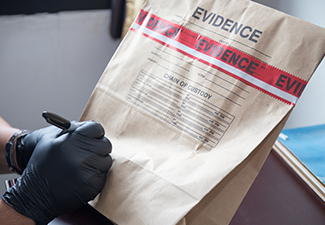Understanding Evidence in a Criminal Trial
Sept. 16, 2022
 One of the most pivotal pillars of the criminal justice system is that of evidence. Evidence is the cornerstone of nearly every criminal case and plays a critical role in prosecution and defense.
One of the most pivotal pillars of the criminal justice system is that of evidence. Evidence is the cornerstone of nearly every criminal case and plays a critical role in prosecution and defense.
At the onset of representation, defendants typically ask two questions about their case, "what is the evidence against me?" and "how does the evidence impact the case?" I don’t think it’s abnormal for those charged with a crime to have a deep curiosity about evidence. Being charged with any crime is a freighting experience and worrying about evidence that may seem stacked against you is even more overwhelming.
If you have been accused of a crime in Springfield, Massachusetts, and are curious about the role of evidence in your case, I’ll encourage you to finish reading and take the next step to get the trusted representation you need. Contact my firm, the Law Office of Joseph M Pacella, to start building your defense. I proudly serve clients throughout Western and Central Massachusetts, including Northampton, Westfield, Amherst, and Palmer.
What Is Evidence?
Evidence serves as a basis for belief. In the criminal justice system, evidence consists of facts and information that is used to prove or disprove a person who has committed a criminal offense.
Although evidence varies in every criminal trial, the majority of all evidence falls within five main types of evidence. These types are:
Real Evidence
Any evidence that was used or was present at the scene of a crime is referred to as real evidence. Real evidence is often the first form of evidence collected and can include weapons, motor vehicles, property, money, drugs, or drug-related items.
Testimonial Evidence
Individuals who witness a crime take place may provide testimonial evidence. Using a person’s statements and observations before, during, and after a crime can help support or deny a criminal charge. Testimonial evidence is typically shared in person during a trial but can also be relevant in the form of a written statement.
Digital Evidence
With technology in mind, digital evidence is anything collected or retrieved from a digital source or device. Some of the most common examples of digital evidence are text messages, emails, and information discovered on hard drives or computers.
Demonstrative Evidence
Demonstrative evidence uses illustrative methods to display facts through charts, graphs, and virtual or physical displays.
Documentary Evidence
Evidence that is discovered in writing, journals, drawings, photographs, and audio or video recordings is referred to as documentary evidence.
Direct vs. Circumstantial Evidence
During a trial, evidence is commonly classified as direct or circumstantial. Understanding the difference plays a critical role for both the prosecution and defense.
Direct evidence clearly establishes a fact and proves something is true or untrue. For example, a security camera captured clear footage of the suspect breaking into a store and stealing property.
Circumstantial evidence relies more on inference and does not provide absolute proof. Circumstantial evidence provides a general suggestion of what may have happened and can be more subjective. For example, a suspect who was seen by a witness running away from the scene of a crime is circumstantial.
Relevance of the Evidence
In order for evidence to be used in court, it must be relevant. For evidence to be relevant, it must show a connection to the case. For example, Suzie has been charged with stealing from the local mall. The prosecution wants to offer that her father refused to buy her clothes the day before the theft. This evidence would be relevant to prove Susie had a motive to steal the clothing.
Oftentimes, relevant evidence is linked together like a chain to create a burden of proof. What makes evidence complex is that even though evidence may be determined relevant, it still may not be admissible in court.
What Evidence May Not Be Admissible?
Not all evidence will make it to trial. One of the most common eliminators of potential evidence is heresy. Heresy is simply speaking on behalf of someone else. For example, if a witness to a crime says they were told by the defendant's friend that they committed the crime, this scenario would be an example of heresy because they did not hear the information first. Unless the individual was directly informed by the defendant, the evidence would not be allowed in court.
The Exclusionary Rule is another eliminator of evidence. In short, the exclusionary rule prohibits the use of any evidence that may have been obtained illegally or in violation of constitutional rights. Most defendants have only a basic understanding of their Miranda rights which is why it is always in your best interest to rely on a criminal defense attorney to analyze the evidence and how it was obtained.
Get Loyal Legal Action
Facing a criminal trial is a scary experience. It’s critical that you understand the scope of your charges and how evidence is being used in the case. At the Law Office of Joseph M Pacella, I have over two decades of legal experience defending clients in almost every possible scenario. Options are always available, and I can walk you through the process from start to finish. If you or a loved one is facing a criminal trial, get the representation you can trust today.
I serve clients in Springfield, Massachusetts, and throughout the Western and Central parts of the state.
